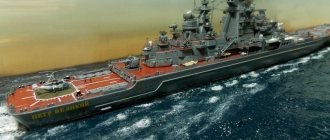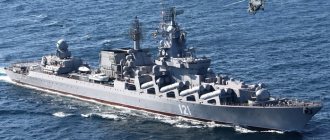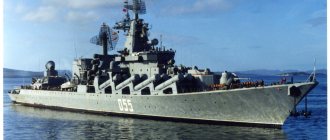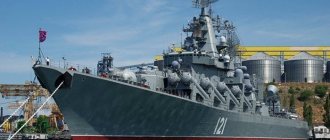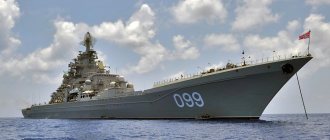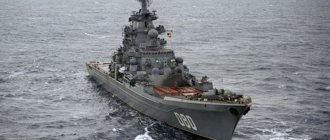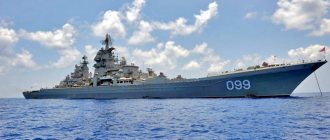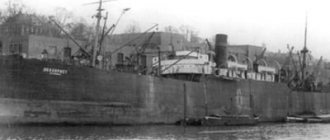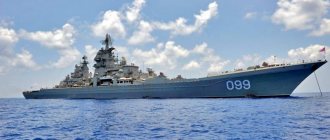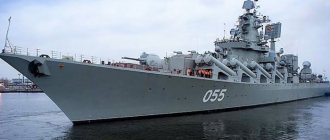TARKR "Peter the Great" The heavy nuclear-powered missile cruiser (TARKR) "Peter the Great" is the largest and currently the only ship of this class in the world. It is designed to destroy large surface targets, protect naval formations from attacks from the air and from enemy submarines, having the ability to operate in any sea and ocean area of the planet.
As part of the Russian Navy, Peter the Great is the flagship of the Northern Fleet and the second largest ship, second only to the heavy aircraft-carrying cruiser (TAKR) Admiral Kuznetsov. Possessing powerful and quite effective weapons, albeit still of Soviet design, “Peter the Great”, to this day, represents a real threat to naval convoys and even carrier strike groups of a potential enemy.
The history of the appearance of TARKR "Peter the Great"
In the mid-1960s, the Soviet Union began designing a new type of surface combat ship with a virtually unlimited range.
Initially, it was planned to create an anti-submarine ship with a displacement of about 8 thousand tons with a nuclear power plant. However, after the appearance in the late 1960s of US Navy submarines with intercontinental missiles and nuclear power plants, it was necessary to create a larger multi-purpose cruiser compared to the previously designed one.
As a result, design work began on Project 1144, the goal of which was to create a heavy nuclear-powered missile cruiser (TARK). The project, called "Orlan", was completed in 1972. Initially, Project 1444 “Orlan” was supposed to build seven ships with a nuclear power plant (NPP). Since 1973, cruisers of this type were laid down and built at the Baltic Shipyard: “Kirov”, “Frunze” and “Kalinin”, and since 1992 they began to be called “Admiral Ushakov”, “Admiral Lazarev” and “Admiral Nakhimov”, respectively.
The shipyard began construction of the next ship, which was destined to become the last in the TARKR series, in April 1986. By the time of its construction, the project had been modernized, receiving the designation 1444.2. The design of the ships did not change; compared to its predecessors, each new cruiser was equipped with more modern weapons systems. When laid down, the ship was called “Kuibyshev”, then for a short time it bore the name “Yuri Andropov”. Ultimately, the most powerful cruiser in the world, launched in 1989, was finally completed after the collapse of the USSR.
10 years after the start of construction, TARKR was able to begin sea trials, conducting them in the harsh conditions of the Arctic. After their completion, the nuclear-powered cruiser, which received the name “Peter the Great” in 1992, was transferred to the Northern Fleet of the Russian Navy, receiving hull number 099. The beginning of the cruiser’s combat service in the Russian fleet dates back to the moment the naval flag was raised on it, which took place on April 18, 1998 .
By that time, the first two cruisers of the Orlan project were decommissioned in the 1990s, and Admiral Nakhimov was mothballed for many years. Since 2013, work has begun on this cruiser on its deep modernization with the aim of re-equipping it with more modern types of weapons, but this process cannot be expected to be completed before 2022.
He will conquer the ocean: which Russian Navy ship will single-handedly hold off the NATO fleet
A nuclear power plant, hypersonic weapons, the latest missile and torpedo weapons - the heavy nuclear missile cruiser Admiral Nakhimov, which has no analogues in the world, will be transferred to the Navy in 2022 after a deep modernization.
In fact, the Northern Fleet will receive a new ship with much greater capabilities than its predecessors. About the features and combat potential of "Nakhimov" - in the material of RIA Novosti correspondent Nikolai Protopopov.
born again
The heavy nuclear missile cruiser Admiral Nakhimov is now in the dry dock of the Northern Machine-Building Enterprise in Severodvinsk. The cruiser underwent repairs in 1999, having served in the navy for about fifteen years.
The ship is expected to enter factory testing this year. The Ministry of Defense said that after the modernization there will be, in fact, a new ship - life support systems, radio equipment and ship power will be radically updated. But the main thing is that the cruiser’s outdated missile and artillery weapons will be replaced with the most modern models.
For various reasons, the ship's delivery date was "shifted to the right" several times. Largely due to the fact that modernization plans were supplemented as work progressed. In particular, several years ago they decided to equip the cruiser with the promising Zircon hypersonic complex, which required additional efforts and, accordingly, an extension of the repair period.
The fact that Admiral Nakhimov will be one of the first ships of the Russian Navy to receive hypersonic missiles was announced in early May by Russian Deputy Defense Minister Alexey Krivoruchko. According to him, the cruiser will become the most powerful combat unit in the Navy, with modern long-range precision weapons.
Thus, Zircon missiles rush to the target nine times faster than sound. This makes them invulnerable to any air defense system - it is almost impossible to intercept the Zircon. The ammunition flies at an altitude of several tens of kilometers over a distance of about a thousand kilometers. At the same time, it constantly changes its trajectory and maneuvers. The warhead is relatively small - two hundred kilograms. But, given the high speed and colossal kinetic energy, this is quite enough to destroy a large surface ship.
According to military experts, the Zircon complex will several times increase the combat capabilities of not only the cruiser Admiral Nakhimov, but also the entire fleet.
“They are waiting for the ship because the missile cruisers that we currently have, Pyotr Velikiy and Marshal Ustinov, need to be strengthened. And if the Admiral Nakhimov is also armed with Zircons, this will make it a ship of special geopolitical significance,” Chairman of the All-Russian Fleet Support Movement, Captain 1st Rank Mikhail Nenashev, previously told RIA Novosti.
floating fortress
Before modernization, the cruiser’s “main caliber” were two dozen missiles of the P-700 “Granit” anti-ship complex, which had a range of 600 kilometers. These missiles were put into service in the early 1980s, and were created specifically to combat aircraft carriers.
The Admiral Nakhimov was protected from air attacks by the S-300F Fort and Osa-M anti-aircraft missile systems, which destroyed all types of air targets at distances from five meters to 150 kilometers. The updated Admiral Nakhimov will receive up to 80 missiles of various types, placed in universal launchers. These are Caliber missiles of various modifications and supersonic anti-ship Onyx missiles. "Caliber" hits ground targets at a distance of about two and a half thousand kilometers, and
"Onyx" is designed to destroy particularly large ships.
Protection will be provided by the Fort-M and Pantsir-M air defense systems. Long-distance lines at distances of up to four hundred kilometers will be covered by the system of the latest Poliment-Redut vertical-launch anti-aircraft missile system.
In addition, powerful anti-submarine weapons are provided. For example, the promising “Response” complex, which destroys enemy submarines at a distance of several tens of kilometers. A small torpedo in the head of the “Response” ammunition is separated from the carrier after hitting a given area and searches for the submarine on its own. The probability of hitting the target is close to 90 percent.
The Package-NK compact defense system is designed to combat both submarines and enemy torpedoes. It is aimed at the target using its own hydroacoustic station in automatic mode. The system classifies attacking torpedoes and determines their movement parameters. "Package-NK" operates in the near defense zone of the ship - up to ten kilometers.
Strategic effect
The former commander of the Northern Fleet, Admiral Vyacheslav Popov, noted in an interview with RIA Novosti that the Russian Navy will receive the most modern ship in terms of strike weapons, radio equipment and air defense.
“Both in Soviet and modern Russian times, Project 1144 ships were and will be of enormous importance for the Navy,” the admiral emphasized. — Cruisers are designed to solve problems in the far ocean zone. Today, military strategy is based primarily on the capabilities of strike weapons; attacks on targets are carried out from long distances. If earlier the fight against missiles directly was in the foreground, now it is more important to confront their carriers.”
Mikhail Nenashev added that Russia needs at least four ships of the Nakhimov class. “The Americans are building strike pennants very quickly - by 2030 they want to commission about a hundred more Arleigh Burke guided-missile destroyers. “Nakhimov” will close one of the gaps. And this is not some kind of expansion, we are just restoring parity,” he noted.
According to the expert, the capabilities of the updated cruiser will allow Russia to defend itself against increasing US aggression when the Americans withdraw from arms limitation treaties.
“With the help of new missile systems, the cruiser is capable of not only destroying ground and sea targets, but also shooting down missiles and satellites threatening from space,” Nenashev said. — “Nakhimov” will effectively cover the country from ocean directions. It is ready to sink large surface targets a thousand kilometers away - just one ship will change the strategic situation in any region of the world. This is very important in the context of the new arms race being unleashed by the United States.”
Experts interviewed by RIA Novosti agreed that Admiral Nakhimov will make the Russian fleet more balanced. With the commissioning of the cruiser, the Russian Navy will be able to solve any problems in the interests of the country's security.
Let us recall that Project 1144 Orlan heavy nuclear missile cruisers began to be developed in the USSR back in the 1960s. The lead ship was laid down in 1973 and delivered to the fleet in 1980. Four such pennants were built. The Orlans are the only surface ships with a nuclear power plant in the Russian Navy. They are considered the largest naval combat platforms in the world - only aircraft carriers are larger than them.
Only the cruiser "Peter the Great" is in service today. It will also go for modernization after completion of work on the Admiral Nakhimov. The other two ships, Admiral Ushakov and Admiral Lazarev, will most likely be scrapped.
Warship design
TARKR "Peter the Great" at the construction stage, unlike its nuclear-powered predecessor cruisers with almost similar characteristics, received increased autonomy (up to 60 days) and an unlimited cruising range. The cruiser's hull has 6 decks, and the superstructure has 8 tiers. In order to increase the survivability of the ship, the most important parts of its hull have armor with a thickness of 50 to 100 mm.
The total number of premises intended for the crew's living activities is about 1,600, including 140 cabins and 30 cockpits, 3 saunas, 15 showers, and a gym. The regular crew size is 1035 people, including 105 officers, 130 midshipmen, 800 sailors. 18 people are flight personnel.
The cruiser's main power plant is equipped with two fast neutron nuclear reactors with a thermal power of 300 MW each and two auxiliary oil steam boilers, which are designed to both increase the overall power of the ship's power plant and provide it with the ability to sail up to 1000 miles without the use of nuclear power plants. The ship's power system also includes 8 steam and gas generators, 4 power plants with a total capacity of 18 MW, and 2 turbines with 75 thousand horsepower.
The cruiser's two propeller shafts rotate along a five-blade propeller.
Cruiser Peter the Great - review with photos and videos
The history of the appearance of TARKR "Peter the Great"
The main danger to the country at that time was the nuclear submarines of a potential enemy. According to the country's leadership, constant control and surveillance of them, and, if necessary, destruction was only possible for large nuclear-powered anti-submarine ships. When designing, designers had to solve a number of complex problems. One of them was set by the Commander-in-Chief of the Navy, Admiral Gorshkov, who expressed concern that both reactors could fail on a long voyage, also pointing out that the ship needed a backup power plant.
As a result, a solution was found - in addition to the two nuclear reactors of the Orlan-class cruiser, it was decided to mount two steam boilers, which is why the heavy missile cruiser acquired two smokestacks, which can be seen by looking at the drawings. The admiral's decision turned out to be far-sighted, as the sailors had to verify repeatedly during their campaigns.
The main strike complex was also not decided immediately. At first, it was planned to equip the heavy missile ship of the Orlan project with subsonic anti-ship missiles Malachite. But the weapons had weak characteristics - first of all, the short firing range of 120 km did not suit the military, so they decided to place significantly more advanced Basalt missiles in eight launchers on the sides.
However, soon the military industry created supersonic cruise missiles "Granit", which were immediately installed on nuclear-powered submarines. “Granit” is an extremely “smart” anti-ship missile that can approach targets at low and ultra-low altitudes. A flock of such missiles is capable of exchanging information with each other, independently detecting and distributing targets to be struck.
Features of the cruiser's strike and defensive weapons
On submarines, Granit launches from launchers filled with water. To save time, the heavy nuclear-powered icebreaker "Peter the Great" received the same drawings - the main attack systems were located below deck for the first time in the world. Because of this, to launch the rocket into the launchers, it was necessary to pump sea water. This, however, only took a few seconds. Twenty missiles can deliver 15 tons of nuclear charges to an enemy AUG at once, while shooting down a Granit is an extremely difficult task even for the most modern air defense systems.
The heavy nuclear cruiser is equipped with a powerful air defense system. The main armament is the Fort complex, developed on the basis of one of the best air defense systems in the world, the S-300. Drum installations located in the bow and stern of the ship could simultaneously fire at 12 targets at once with an interval of 4 seconds. As a result of various modifications and modernizations, “Peter the Great” received a lot of other anti-aircraft, anti-submarine and artillery weapons. This is a multifunctional heavy cruiser capable of providing cover for a group of ships from sea and air targets, detecting and destroying submarines, and supporting ground forces in the coastal zone.
The first of the Project 1144 Orlans, the nuclear-powered missile cruiser Kirov, left the Baltic Shipyard in May 1979. Later, 4 more similar nuclear-powered ships were laid down at the same plant. The last one was the “Peter the Great”, laid down, almost completely built and launched in the USSR as the TARKR “Andropov”, and completed and tested in Russia. True, due to the general lack of funding, the ship was practically abandoned for a long time - birds had already begun to build nests on the superstructures of the nuclear-powered ship that were most convenient for them. What was not forgotten was the renaming of the ship. It was at this time that the nuclear-powered aircraft-carrying cruiser was named “Peter the Great”. Completion of the ship continued in 1995.
The Russian TARKR "Peter the Great" has the following characteristics:
-full displacement more than 26,000 tons; -crew – 727 people plus flight personnel 18 people; - the mines of the main attack weapons - the Granit missile launcher - are located below the deck in the bow of the ship; -in the aft part there is a helicopter hangar and the main power plant - two fast neutron reactors of 300 MW each, as well as an auxiliary plant - a pair of oil steam boilers.
Armament of the cruiser "Peter the Great"
The cruiser's main armament is 20 P-700 Granit supersonic anti-ship missiles, developing a speed of 2.5 M and weighing 7 tons each. Capable of hitting targets at a distance of 600 km with a high-explosive warhead weighing 750 kg or a nuclear charge with a power of 500 kt. Anti-aircraft systems - the bow complex "FORT-M" or S-300 FM with 46 missiles, as well as one complex with 48 S-300 F missiles. In addition, there is a short-range complex "Dagger" - a development of the Osa-MA system , installed on early Orlans. Anti-aircraft weapons are reinforced by the Kortik anti-aircraft missile and artillery system, which hits targets with missile weapons at a distance of 8000-1500 m, and artillery weapons - from 1500 to 500 m.
The anti-submarine weapons of the cruiser "Peter the Great" are the Volgopad-NK system consisting of twenty anti-submarine missiles or torpedoes, the Udav-1 complex with 40 anti-submarine missiles. This type of weapon also includes RBU-1000 missile and bomb launchers and three Ka-27PL helicopters equipped with anti-submarine weapons.
In short, the nuclear-powered aircraft-carrying cruiser “Peter the Great” is the real beauty and pride of the Russian fleet. This is a powerful combat unit, the last of the 1144 Orlan project, and in the 21st century it is capable of defending the interests of our country anywhere in the world’s oceans.
Video about the cruiser
Specifications
Scheme of TARKR "Peter the Great"
The main performance characteristics of "Peter the Great" include:
- Length - 250.1 m;
- Width at the waterline - 25 m;
- Height from the level of the main plane - 59 m;
- Draft - 10.3 m;
- Standard displacement - 23,750 tons;
- Total displacement - 25,860 tons;
- Maximum speed is 32 knots.
Features of the cruiser's strike and defensive weapons
Anti-aircraft, strike, and anti-submarine weapons allow the Peter the Great TARKR to solve almost any combat mission. In terms of the totality of its strike missile power, the flagship of the Russian Northern Fleet is superior to any of the cruisers in the world, including the American Ticonderoga-class missile cruisers, which, despite their impressive number of cruise missiles, have a rather “narrow specialization.”
The Peter the Great's superstructures carry many radars and antennas for early warning systems. In particular, the detection of air targets is entrusted to three radar stations for various purposes, among which there is a system for detecting low-flying targets. It is the absence of such a specialized radar that makes the American Aegis system vulnerable.
In general, the flagship of the Russian Northern Fleet, Peter the Great, has reliable protection against a surprise attack, capable of effectively responding to any missile threat from the air in 8-24 seconds, and to an underwater attack in 15 seconds. The cruiser's own electronic warfare systems and guidance systems also significantly surpass their American counterparts in their characteristics.
Firing training from the heavy nuclear-powered missile cruiser "Peter the Great"
On sale:
- Delivery and pickup
- Description
- Reviews 1
- Reviews 0
- Guarantee
- Gallery 2
The arrival of goods is expected: Prefabricated model ZVEZDA 9017P Cruiser “Peter the Great”.
You can subscribe to be notified when this product goes on sale. Notify when a product is on sale
You can choose a product in the Prefabricated models for gluing category.
Prefabricated model ZVEZDA 9017P Cruiser "Peter the Great"
Historical information: Flagship of the Russian Northern Fleet. The world's largest operational attack combat ship (not an aircraft carrier) as of 2016. The heavy nuclear missile cruiser of the Peter the Great project is a highly complex system in combat and technical terms with the most modern weapons and reconnaissance equipment. "Peter the Great" was created as a nuclear deterrent and cover for ballistic missile submarines.
The main armament of the cruiser
20 supersonic anti-ship missiles P-700 "Granit"
High-precision anti-ship cruise missiles "Granit" on the "Peter the Great" are located in 20 SM-233 launchers under the upper deck. Rocket length - 10 m, caliber - 0.85 m, launch weight - 7 tons. The warhead is a monoblock in nuclear (500 kilotons) or conventional (750 kg of explosive) ammunition, and can also carry a volumetric explosion fuel-air warhead. Firing range - up to 625 km, flight speed - up to 2.5 M (at altitude) and up to 1.5 M at the surface of the water.
These missiles have an integrated-autonomous control system: their flight is coordinated by the “leader”, if he is defeated by missile defense means, his functions are automatically transferred to the new leader. In combination with radio interference and decoys, a full-scale salvo of Granites from the Peter the Great becomes almost irresistible, with at least serious damage to the main target.
Anti-aircraft systems
| Characteristics | S-300 "Fort" | S-300 "Fort-M" | SAM "Dagger" | ZRAK "Dirk" |
| Number of PU | 6 | 6 | 16 | 6x8 |
| Missile stock | 48 | 48 | 128 | 144 |
| Range, km | Up to 150 | Up to 200 | 1,5-12 | 1,5-8 |
| Target engagement altitude, km | 0,025-25 | 0,01-25 | 0,01-6 | 0,005-3,5 |
| Warhead mass, kg | 145 | 180 | 15 | 9 |
Anti-aircraft missile systems (SAM) S-300 “Fort” and “Fort-M” are respectively located in the stern and bow of the cruiser “Peter the Great”.
Anti-aircraft weapons
The artillery component of the anti-aircraft weapons includes 30-mm automatic six-barreled AK-630 mounts as part of the Kortik air defense system (two in each launcher) with a total ammunition capacity of 48 thousand shells. The total rate of fire of these installations is about 10 thousand rounds per minute, the parameters for effective firing at air targets are 500-4000 m in range and 5-3000 m in altitude. Muzzle covers are placed on the barrel blocks to protect the installation and containers with missiles from powder gases. The first-stage ammunition is placed in two drums of 500 rounds of ammunition next to the barrel blocks; the machine guns are powered not by a belt, but by a screw (linkless).
Artillery part of the weapon
The basis of the Peter the Great's artillery armament is the twin 130-mm AK-130 multi-purpose artillery mount, capable of hitting coastal, sea and air targets. The barrels have a length of 70 calibers and a maximum elevation angle of 85 degrees, which ensures a gun range of up to 25 km. Rate of fire - from 20 to 90 rounds per minute. The mass of explosives contained in high-explosive fragmentation shells with various types of fuses is 3.56 kg. The ammunition prepared for firing includes 180 shells, and their total ammunition on the ship is 840 shells.
The guns can operate in fully automatic control and aiming mode, as well as in manual mode. The MP-184 fire control system allows for simultaneous tracking and firing of two targets.
"Peter the Great" has reliable protection against surprise attacks from the air and from under water
Anti-submarine weapons
The cruiser's anti-submarine weapons are equipped with the Vodopad-NK anti-submarine missile system, the Udav-1 anti-torpedo system, RBU-1000 missile and bomb launchers and Ka-27PL helicopters.
The Vodopad-NK anti-submarine missile system has 20 anti-submarine missiles capable of operating at a range of up to 50 km and carrying either a nuclear charge or a small-sized homing torpedo UGMT-1, with a speed of up to 41 knots. Firing is carried out from 10 launchers (PU) - 533 mm caliber missile and torpedo tubes. After this, the missile launches into the air from the water surface and delivers its warhead to the target area.
The Udav-1 anti-torpedo system is equipped with 40 missiles for firing from 10 RBU launchers (rocket-propelled bomb launchers) with a caliber of 300 mm, capable of hitting enemy torpedoes and submarines at a distance of up to 3 km. The cruiser Admiral Kuznetsov has a similar system.
The Smerch-3 anti-torpedo protection system, which includes:
- two six-tube remotely guided anti-submarine missile launchers RBU-1000 (ammunition capacity of 102 missiles with a range of up to 1 km and a charge weight of 55 kg);
- charger;
- RSL-10 depth charges;
- the “Storm” system, which controls the fire of up to four RBUs.
Two Ka-27PL helicopters are also designed for anti-submarine protection, equipped with anti-submarine equipment: search radar, sonobuoys, acoustic system and magnetic anomaly detectors. The third of the Ka-27 cruisers is equipped as a search and rescue helicopter. But all three aircraft can be armed with anti-submarine torpedoes, bombs, mines, and anti-ship missiles.
Cruiser "Peter the Great"
Cruiser Peter the Great - review with photos and videos
The history of the appearance of TARKR "Peter the Great"
The main danger to the country at that time was the nuclear submarines of a potential enemy. According to the country's leadership, constant control and surveillance of them, and, if necessary, destruction was only possible for large nuclear-powered anti-submarine ships. When designing, designers had to solve a number of complex problems. One of them was set by the Commander-in-Chief of the Navy, Admiral Gorshkov, who expressed concern that both reactors could fail on a long voyage, also pointing out that the ship needed a backup power plant.
As a result, a solution was found - in addition to the two nuclear reactors of the Orlan-class cruiser, it was decided to mount two steam boilers, which is why the heavy missile cruiser acquired two smokestacks, which can be seen by looking at the drawings. The admiral's decision turned out to be far-sighted, as the sailors had to verify repeatedly during their campaigns.
The main strike complex was also not decided immediately. At first, it was planned to equip the heavy missile ship of the Orlan project with subsonic anti-ship missiles Malachite. But the weapons had weak characteristics - first of all, the short firing range of 120 km did not suit the military, so they decided to place significantly more advanced Basalt missiles in eight launchers on the sides.
However, soon the military industry created supersonic cruise missiles "Granit", which were immediately installed on nuclear-powered submarines. “Granit” is an extremely “smart” anti-ship missile that can approach targets at low and ultra-low altitudes. A flock of such missiles is capable of exchanging information with each other, independently detecting and distributing targets to be struck.
Features of the cruiser's strike and defensive weapons
On submarines, Granit launches from launchers filled with water. To save time, the heavy nuclear-powered icebreaker "Peter the Great" received the same drawings - the main attack systems were located below deck for the first time in the world. Because of this, to launch the rocket into the launchers, it was necessary to pump sea water. This, however, only took a few seconds. Twenty missiles can deliver 15 tons of nuclear charges to an enemy AUG at once, while shooting down a Granit is an extremely difficult task even for the most modern air defense systems.
The heavy nuclear cruiser is equipped with a powerful air defense system. The main armament is the Fort complex, developed on the basis of one of the best air defense systems in the world, the S-300. Drum installations located in the bow and stern of the ship could simultaneously fire at 12 targets at once with an interval of 4 seconds. As a result of various modifications and modernizations, “Peter the Great” received a lot of other anti-aircraft, anti-submarine and artillery weapons. This is a multifunctional heavy cruiser capable of providing cover for a group of ships from sea and air targets, detecting and destroying submarines, and supporting ground forces in the coastal zone.
The first of the Project 1144 Orlans, the nuclear-powered missile cruiser Kirov, left the Baltic Shipyard in May 1979. Later, 4 more similar nuclear-powered ships were laid down at the same plant. The last one was the “Peter the Great”, laid down, almost completely built and launched in the USSR as the TARKR “Andropov”, and completed and tested in Russia. True, due to the general lack of funding, the ship was practically abandoned for a long time - birds had already begun to build nests on the superstructures of the nuclear-powered ship that were most convenient for them. What was not forgotten was the renaming of the ship. It was at this time that the nuclear-powered aircraft-carrying cruiser was named “Peter the Great”. Completion of the ship continued in 1995.
The Russian TARKR "Peter the Great" has the following characteristics:
-full displacement more than 26,000 tons; -crew – 727 people plus flight personnel 18 people; - the mines of the main attack weapons - the Granit missile launcher - are located below the deck in the bow of the ship; -in the aft part there is a helicopter hangar and the main power plant - two fast neutron reactors of 300 MW each, as well as an auxiliary plant - a pair of oil steam boilers.
Armament of the cruiser "Peter the Great"
The cruiser's main armament is 20 P-700 Granit supersonic anti-ship missiles, developing a speed of 2.5 M and weighing 7 tons each. Capable of hitting targets at a distance of 600 km with a high-explosive warhead weighing 750 kg or a nuclear charge with a power of 500 kt. Anti-aircraft systems - the bow complex "FORT-M" or S-300 FM with 46 missiles, as well as one complex with 48 S-300 F missiles. In addition, there is a short-range complex "Dagger" - a development of the Osa-MA system , installed on early Orlans. Anti-aircraft weapons are reinforced by the Kortik anti-aircraft missile and artillery system, which hits targets with missile weapons at a distance of 8000-1500 m, and artillery weapons - from 1500 to 500 m.
The anti-submarine weapons of the cruiser "Peter the Great" are the Volgopad-NK system consisting of twenty anti-submarine missiles or torpedoes, the Udav-1 complex with 40 anti-submarine missiles. This type of weapon also includes RBU-1000 missile and bomb launchers and three Ka-27PL helicopters equipped with anti-submarine weapons.
In short, the nuclear-powered aircraft-carrying cruiser “Peter the Great” is the real beauty and pride of the Russian fleet. This is a powerful combat unit, the last of the 1144 Orlan project, and in the 21st century it is capable of defending the interests of our country anywhere in the world’s oceans.
Video about the cruiser
Advantages and disadvantages
The Project 1144 Orlan heavy nuclear missile cruisers did not have and do not have direct analogues abroad. The variety of weapons of the TARKR "Peter the Great" made this ship multi-purpose, although the downside of this situation was its increased complexity in maintenance and, which is also important, the high cost of ensuring combat access to the sea. An important advantage is the high degree of protection of the ship from missile and torpedo attacks.
But at the same time, experts note that even such a powerful ship alone will not be able to fully fight; all its advantages can be most manifested only as part of a strike force. In Soviet times, TARKR were planned as the basis of a naval strike group (KUG), which was quite capable of dealing with even the most powerful enemy carrier strike group. To date, for “Peter the Great” this is only possible after replacing the main weapons systems developed in the USSR with newer ones. Since it must be taken into account that it is almost impossible to ensure the secrecy of the appearance of such a powerful ship in any area of the world's oceans.
On sale:
- Delivery and pickup
- Description
- Reviews 1
- Reviews 0
- Guarantee
- Gallery 2
The arrival of goods is expected: Prefabricated model ZVEZDA 9017P Cruiser “Peter the Great”.
You can subscribe to be notified when this product goes on sale. Notify when a product is on sale
You can choose a product in the Prefabricated models for gluing category.
Prefabricated model ZVEZDA 9017P Cruiser "Peter the Great"
Historical information: Flagship of the Russian Northern Fleet. The world's largest operational attack combat ship (not an aircraft carrier) as of 2016. The heavy nuclear missile cruiser of the Peter the Great project is a highly complex system in combat and technical terms with the most modern weapons and reconnaissance equipment. "Peter the Great" was created as a nuclear deterrent and cover for ballistic missile submarines.
Suitable as a gift for both a beginning modeler and an experienced modeler.
Attention! The gift set includes only basic paints.
Combat use
The Peter the Great TARKR did not have to participate in combat operations that required direct engagements with enemy attack ships. The main content of his service in the Russian Navy was activities related to combat training. The ship took part in a variety of exercises many times and made several long-distance voyages. The cruiser "Peter the Great" visited all the oceans of the Earth, traveled more than 170 thousand nautical miles, and has completed a circumnavigation.
The cruiser "Peter the Great" on a long voyage
However, the ship had the opportunity to take part in several quite important operations that went down in the history of the Russian navy.
In August 2000, the cruiser discovered the site of the sinking of the Kursk nuclear submarine and then patrolled the area during the operation to raise the sunken submarine.
In February 2009, the Peter the Great, during one of its long voyages, was able to detain three ships of Somali pirates in the Gulf of Aden, although the use of a heavy missile cruiser in this case was caused only by a special coincidence of circumstances.
In July 2012, the TARKR "Peter the Great" became the first ship in the history of the modern Russian Navy to be awarded the Order of Nakhimov.
From October 2016 to February 2022, "Peter the Great" carried out long-range missions in the Northeast Atlantic and Mediterranean Sea, ensuring the combat stability of the Northern Fleet carrier group, which for the first time took part in a combat operation to combat international terrorism in Syria with the use of attack aircraft from a Russian aircraft carrier against militant targets.
In the near future, there is reason to expect that the further service of the Peter the Great will be extended for a very long period after a deep modernization, similar to the one currently being carried out on the same type cruiser Admiral Nakhimov.
